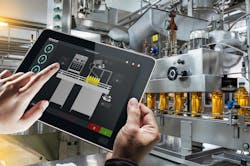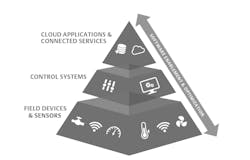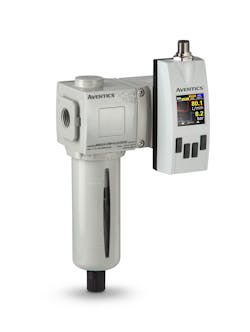Optimizing operations from floor to cloud with energy monitoring
Process manufacturers face competing pressures. They must meet sustainability targets as well as customer demand despite labor shortages and skills gaps. To remain competitive in a global market, it is essential that process manufacturers excel in all these areas at once. By integrating intelligent energy monitoring solutions into processing and packaging lines, process manufacturers can begin to significantly improve efficiency and productivity — while also achieving greater sustainability.
Energy monitoring unlocks critical process insights that can optimize operations and energy use while adding the capability to reduce manual audits and processes that increase staff availability and reduce unplanned downtime. By building intelligence that drives continuous improvement into processing and packaging systems, manufacturers from the chemical sector and food and beverage industries can maximize existing assets and talent, improve production output, empower a stretched workforce and reduce resource use.
Seeing the difference
A Floor-to-Cloud approach is one of many approaches to digital transformation and automation that a company can undertake. Unlike other tactics, a Floor-to-Cloud method starts by taking a pragmatic approach by identifying a known problem/specific challenge rather than a product or one-size-fits-all solution. And the challenge many process manufacturers face when it comes to energy is that they do not have the resolution or access to detailed local data around how much energy usage and trending data a specific machines or line uses — this can ultimately allow users to identify largest consumers of energy and prioritize those to further reduce waste. Energy monitoring can make both clear.
A complete approach to energy monitoring gives process manufacturers real-time visibility of trends, benchmarks and control over energy use. With this level of clarity and power, process manufacturers can make decisions that optimize consumption and reduce waste while increasing machine availability and streamlining processes.
The comprehensive nature of the approach is suggested in its name: It starts on the plant floor with valves and sensors that collect and send data to edge hardware and controllers equipped with analytics software. Integrating software within edge devices translates that data into valuable insights that scale in the cloud. A dashboard puts detailed guidance and awareness into operators’ hands.
Using these insights, the right people can perform the right actions in the right place at the right time. In this way, each machine or process can receive exactly what it needs when it needs it, using only the energy required.
For instance, processing and packaging lines rely on pneumatic technologies, making compressed air a critical energy source in most plants. Depending on the facility, compressed air can account for between a fifth to a third of electricity use. A significant portion of that — about a third — is lost to leaks and process inefficiencies that use more air than they need.
By continuously tracking pneumatic systems, energy monitoring allows operators to detect and address leaks and other issues in their early stages. This fast action, continually practiced, can reduce compressed air consumption by 20%-30% and unplanned downtime by 20% while improving overall equipment effectiveness by at least 5%-10%.
Simultaneously improve sustainability, efficiency and productivity
A Floor-to-Cloud approach to energy monitoring automates or digitalizes every step of the See, Decide, Act cycle.
- During the See stage, intelligent sensors are securely connected to a network that continuously monitors airflow. Real-time data feeds provide insights into pneumatic system energy consumption and health.
- In the Decide stage, sensors transmit collected data to an edge device that continuously aggregates data and transmits it to analytics software that contextualizes and visualizes data. Operators can see statistics, diagnostics and trends, including energy efficiency, on a single dashboard. This insight empowers operators to make fast, informed decisions that set meaningful action in motion.
- This continues into the Act stage, during which analytics software sends notifications that contain clear instructions. For energy monitoring, this may be how to improve energy efficiency or how and where to find compressed air leaks. By following these directives, personnel can resolve issues quickly, waste less energy and keep machines running.
While it may seem obvious how this continuous cycle can improve sustainability, efficiency and productivity, understanding it in practice illustrates its full potential in each area. Take again pneumatic energy monitoring.
On average, 76% of companies manually test for compressed air leaks. Manual testing can be an internal task, with trained personnel that go to every machine and check every tube to ensure they are properly connected. Either way, it is expensive, costing an average of $46,000 per machine, and periodic, meaning that leaks have time to grow between audits.
In addition to driving up energy costs and emissions, long-term leaks can negatively affect machine operation, making equipment work harder to do the same work. This can cause unnecessary wear that leads to failure and unplanned downtime.
In comparison, smart pneumatic flow sensors monitor air consumption in pneumatic systems in real time, measuring key parameters like temperature, pressure, humidity and energy use. Depending on where manufacturers place sensors, pneumatic sensors can provide a clear picture of compressed air behavior for a given line, factory or entire plant. Operators can see what is happening for every area being monitored from one dashboard, and analytics software sends detailed alerts to specified personnel when values deviate from established baseline performance.
This type of energy monitoring streamlines detection and empowers a process manufacturer’s existing personnel — regardless of experience — by automating manual processes and providing the right guidance at the right time. Personnel can address compressed air inefficiencies and other issues in their early stages, which can save energy, reduce emissions, prevent failures and improve equipment efficiency.
When manufacturers improve equipment efficiency, operational processes become more efficient and productivity naturally improves. Machine failures or underutilization can negatively affect the productivity of packaging lines. On average typical packaging machines operates at only 65% effectiveness (OEE), leaving a lot of room for efficiency improvement. Energy monitoring can significantly improve overall equipment effectiveness (OEE) and, in turn, a plant’s operating capacity.
In addition to compressed air leaks and sub-optimization, manufacturers can improve OEE by using energy monitoring to balance pneumatic devices like actuators. These devices have an optimal ratio of pressure to airflow and, when operators balance this ratio, the right amount of pneumatic energy effectively powers processes. If devices get too much pneumatic energy, processes run inefficiently and waste energy. And if devices get too little pneumatic energy, processes run ineffectively and can product quality issues can occur.
Taking the first step
A Floor-to-Cloud approach to digital transformation looks different for every process manufacturer because every process manufacturer — their facilities, machines, needs and goals — is different. By starting with a specific problem rather than a product or specific solution, this approach to energy monitoring can address a process manufacturer’s distinct goals and requirements according to their existing machines, facilities and infrastructure.
Taking a Floor-to-Cloud approach can create solutions are modular, flexible and scalable, ultimately enabling users to maximize and capture value at scale. Companies of all sizes and stages of digital transformation can begin by working with an expert to identify one energy opportunity, such as a machine or packaging line, then develop and deploy a solution. Once they identify an area of opportunity, process manufacturers can work with their partners to develop and deploy architectures with the devices, hardware and software configured to the opportunity’s unique requirements and the process manufacturer’s goals. The overall solution then integrates with their existing equipment and infrastructure.
Once process manufacturers prove return on investment, they can scale up. Beyond compressed air and electricity, monitoring can easily extend to other utilities and media, including water, steam and gases. And, in addition to multimedia monitoring, a solution that starts at the factory floor and scaled on the cloud can integrate all parts of processing and packaging equipment and systems, to continuously improve machine availability, throughput and OEE. Specially engineered software modules can automate other processes and allow operators to more deeply address specific challenges and goals.
Continuous improvement powers continued success
There are many different approaches a process manufacturer can take to energy monitoring. A Floor-to-Cloud approach gives process manufacturers real-time visibility and control that can maximize the equipment and resources they already have and optimize their operations.
Many process manufacturers have included energy monitoring as a core part of their corporate sustainability strategies and have seen its extended benefits. Energy monitoring is a proven, reliable way to improve energy efficiency that offers transparency, agility and growth opportunities.
A Floor-to-Cloud approach to energy monitoring can maximize the resources a facility has, automate processes and provide intelligence that helps process manufacturers overcome challenges and reach their goals. With smarter packaging lines and more efficient processes, process manufacturers can continuously improve operations and reach new levels of sustainability, efficiency and productivity.
Amit Patel has been with Emerson since 2017 and is the Director of Intelligent Automation at Emerson. He focuses driving the marketing direction & executing intelligent hardware & software solutions across the Discrete Automation business. Amit earned his Bachelors of Science degree in Electrical Engineering Technology from The New Jersey Institute of Technology and holds a Six Sigma Black Belt for Process Improvement using statistical methodologies.
About the Author
Amit Patel
Director Intelligent Automation at Emerson
Amit Patel has been with Emerson since 2017 and is the Director of Intelligent Automation at Emerson. He focuses driving the marketing direction & executing intelligent hardware & software solutions across the Discrete Automation business. Amit earned his Bachelors of Science degree in Electrical Engineering Technology from The New Jersey Institute of Technology and holds a Six Sigma Black Belt for Process Improvement using statistical methodologies.



